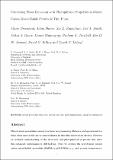Correlating phase behavior with photophysical properties in mixed-cation mixed-halide perovskite thin films
Abstract
Mixed cation perovskites currently achieve very promising efficiency and operational stability when used as the active semiconductor in thin‐film photovoltaic devices. However, an in‐depth understanding of the structural and photophysical properties that drive this enhanced performance is still lacking. Here the prototypical mixed‐cation mixed‐halide perovskite (FAPbI3)0.85(MAPbBr3)0.15 is explored, and temperature‐dependent X‐ray diffraction measurements that are correlated with steady state and time‐resolved photoluminescence data are presented. The measurements indicate that this material adopts a pseudocubic perovskite α phase at room temperature, with a transition to a pseudotetragonal β phase occurring at ≈260 K. It is found that the temperature dependence of the radiative recombination rates correlates with temperature‐dependent changes in the structural configuration, and observed phase transitions also mark changes in the gradient of the optical bandgap. The work illustrates that temperature‐dependent changes in the perovskite crystal structure alter the charge carrier recombination processes and photoluminescence properties within such hybrid organic–inorganic materials. The findings have significant implications for photovoltaic performance at different operating temperatures, as well as providing new insight on the effect of alloying cations and halides on the phase behavior of hybrid perovskite materials.
Citation
Greenland , C , Shnier , A , Rajendran , S K , Smith , J A , Game , O S , Wamwangi , D , Turnbull , G A , Samuel , I D W , Billing , D G & Lidzey , D G 2019 , ' Correlating phase behavior with photophysical properties in mixed-cation mixed-halide perovskite thin films ' , Advanced Energy Materials , vol. Early View , 1901350 . https://doi.org/10.1002/aenm.201901350
Publication
Advanced Energy Materials
Status
Peer reviewed
ISSN
1614-6832Type
Journal article
Description
C.G. and J.A.S. would like to thank the UK EPSRC for funding their Ph.D. studentships via the Centre for Doctoral Training in “New and Sustainable Photovoltaics” (EP/L01551X/1). The authors also thank the UK STFC and EPSRC for part‐funding this work via grants ST/R002754/1 “Synchrotron Techniques for African Research and Technology” and “Hybrid Polaritonics” (EP/M025330/1). A.S. hereby acknowledges the financial assistance of the South Africa National Research Foundation (NRF), University of the Witwatersrand – Material and Energy Research Group (MERG) and DST‐NRF Centre of Excellence in Strong Materials (CoE‐SM) toward this research.Collections
Items in the St Andrews Research Repository are protected by copyright, with all rights reserved, unless otherwise indicated.

